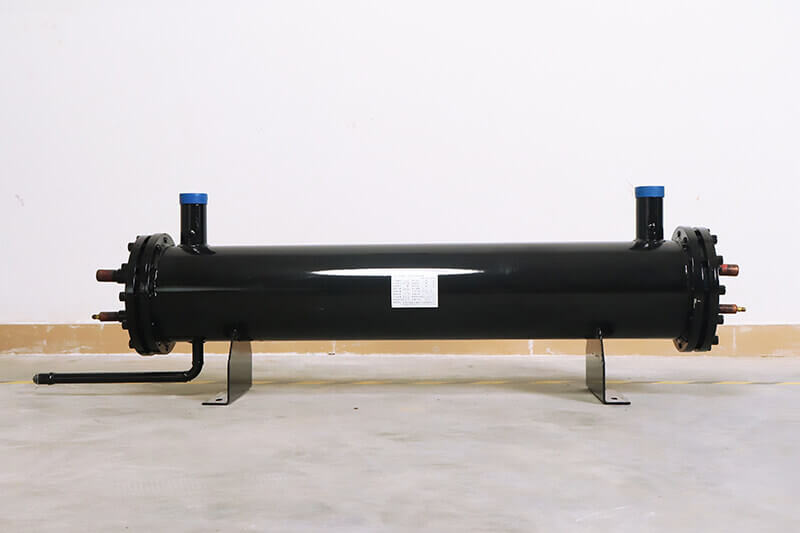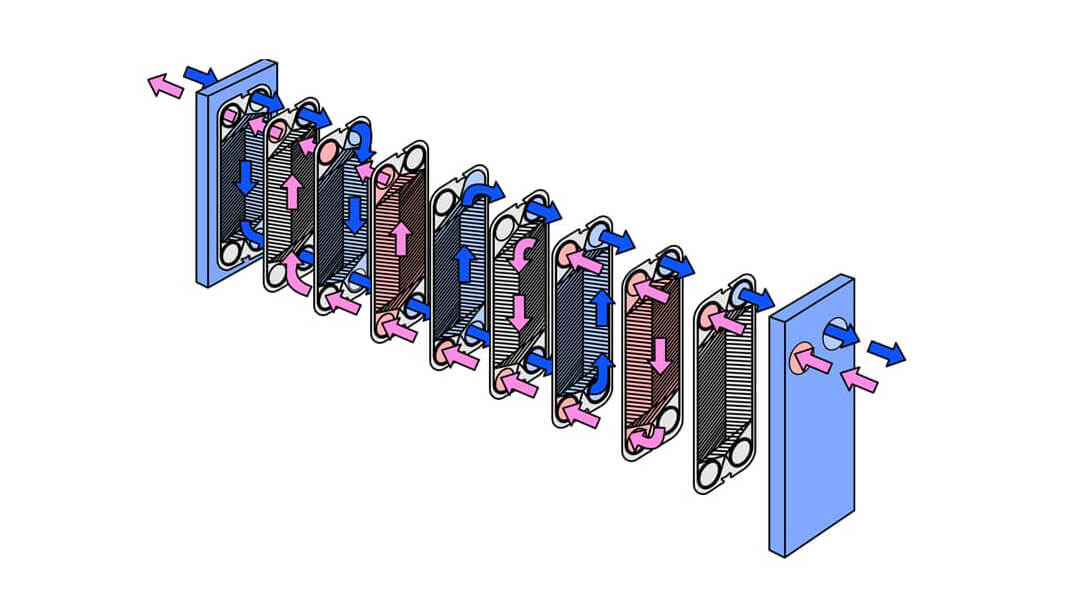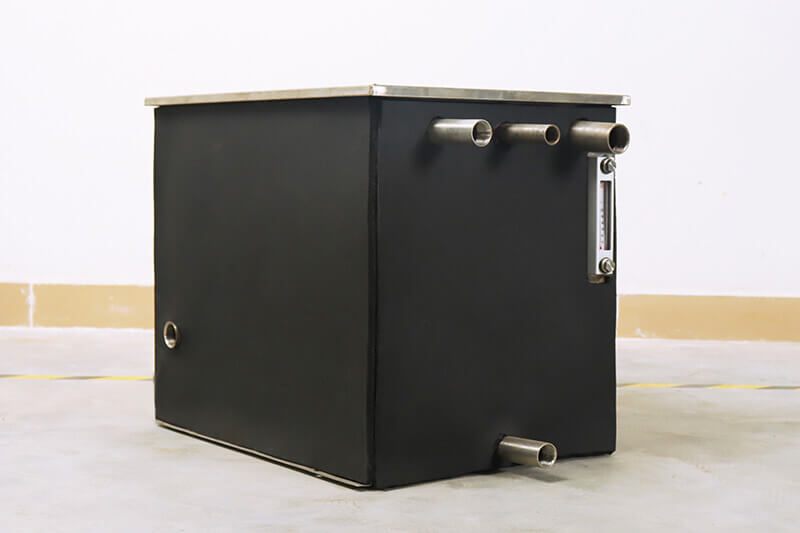What’s a Chiller Evaporator?
An evaporator is the chiller component that absorbs heat from a process fluid—often water or a water-glycol mix—turning it into a cold output ready to cool spaces or equipment. It’s where low-pressure refrigerant, cold from the expansion valve, meets a warmer fluid and boils into a gas, soaking up heat in the process. Think of it as the starting line for cooling, kicking off the refrigeration cycle before the compressor and condenser take over. From small 5-ton units in retail stores to massive 1,000-ton systems in factories, evaporators handle refrigerants like R-410A or ammonia, chilling fluids to 40°F (4°C) or lower, depending on the job.
How Does It Work?
The evaporator’s job is simple but clever, relying on a heat exchange process within the refrigeration cycle. Here’s how it unfolds:
- Cold Refrigerant Arrives: Refrigerant, such as R-410A, enters as a low-pressure mix of liquid and gas, typically at 35°F (2°C), fresh from the expansion valve’s pressure drop.
- Heat Exchange Happens: The refrigerant flows through tubes or plates inside the evaporator, meeting a warmer fluid—like water at 54°F (12°C) returning from a building or process. As it absorbs heat, the refrigerant boils, turning fully into a gas and pulling out about 80-100 BTUs per pound of heat.
- Chilled Fluid Leaves: The water drops to around 44°F (7°C), now ready to cool air handlers, machinery, or other systems. The gaseous refrigerant, warmed but still low-pressure, heads to the compressor to continue the cycle.
This heat-grabbing action is relentless. A 100-ton evaporator might remove 1.2 million BTUs an hour—enough to chill a mid-sized office or keep a food processing line cold. The key is the refrigerant’s boiling point, carefully controlled by pressure to match the cooling need.
Types of Evaporators
Evaporators come in different designs to suit various applications, from small commercial chillers to industrial giants. Here’s a rundown:
By Flow Path:
- One-pass: Water flows straight through, simple for smaller systems with modest cooling needs.
- Two-pass: Water loops back once, boosting heat transfer for medium-sized chillers, ideal for balanced efficiency and space.
- Three-pass: Water snakes through multiple times, compact and efficient for large systems where space is tight, offering up to 20% better heat exchange than one-pass.
By Construction:
- شیل اور ٹیوب: A steel shell holds refrigerant, with copper or stainless steel tubes carrying water. It’s rugged, perfect for big chillers (100+ tons) like those in factories or hospitals, handling high-pressure refrigerants like ammonia.

- پلیٹ: Stacked metal plates alternate refrigerant and water for fast heat transfer. Compact and lightweight, they’re great for smaller setups (5–50 tons), like office buildings or workshops, but need clean water to avoid clogging.

- Coil: Coiled tubes carry refrigerant, simple and cheap for tiny systems (under 10 tons), like portable chillers, but less efficient due to limited surface area.
Each type has its niche—shell and tube for heavy-duty cooling, plate for space-saving efficiency, and coil for budget-friendly small jobs.


Why Evaporators Matter
Evaporators are the backbone of cooling, delivering:
- Precision Cooling: They keep fluids at exact temperatures, like 44°F for HVAC or 35°F for industrial processes, ensuring comfort or product quality.
- Efficiency: Well-designed evaporators maximize heat transfer, cutting energy use by up to 15% compared to older models, saving thousands on bills.
- اعتبار: They handle tough conditions, from freezing ammonia to high-pressure R-410A, keeping systems running 24/7.
- استرتا: From chilling a data center’s servers to freezing food, they adapt to diverse needs.
For example, a brewery might use a shell and tube evaporator to cool wort to 55°F (13°C), ensuring consistent beer quality, while a 20-ton plate evaporator keeps a retail store comfy at 72°F (22°C).
Choosing the Right Evaporator
Picking an evaporator depends on:
- کولنگ بوجھ: Match capacity to your need—e.g., 1.2 million BTUs for a 100-ton chiller. Calculate: BTU/h = Flow Rate (GPM) × 500 × ΔT (°F).
- بہاؤ کی شرح: Ensure 2.5–3 GPM per ton for efficient heat transfer, like 250 GPM for a 100-ton unit.
- جگہ: Plate for tight spots, shell and tube for big setups with room.
- ٹھنڈا: Ammonia for industrial, R-410A for commercial—check compatibility.
- دیکھ بھال: Easy-clean designs, like removable tube bundles, save time.
A pro can help size it right, avoiding overspending or underperformance.
بحالی کے نکات
Keep evaporators humming with:
- صفائی: Clear scale or algae every 6–12 months—brushes for tubes, acid wash for plates—to maintain efficiency.
- Insulation: Use ¾-inch foam to stop heat gain, saving 5–10% on energy.
- Refrigerant Checks: Monitor levels quarterly; a 5% loss cuts cooling by 8%.
- پانی کامعیار: Use clean, treated water to prevent corrosion, testing pH monthly (7–8.5 ideal).
- نگرانی: Track outlet temps (e.g., 44°F) and pressures (30–50 psi) to catch issues early.
Good care can extend evaporator life to 20 years, cutting downtime and costs.
نتیجہ اخذ کرنا
Chiller evaporators are indispensable for high-performance laser cutting systems, providing the necessary cooling to maintain precision and protect equipment. By understanding their function, types, and importance, users can make informed decisions when selecting and maintaining these critical components. Whether in a small workshop or a large factory, the right evaporator ensures that your laser cutting operations run smoothly and efficiently, delivering high-quality results every time. For further reading or to explore specific chiller models, consider consulting reputable sources or manufacturers specializing in laser cooling solutions.
FAQ: Common Questions About Chiller Evaporators
1. What is a chiller evaporator?
It’s the part of a chiller where refrigerant absorbs heat from a fluid, like water, cooling it for use in air conditioning or industrial processes. The refrigerant boils into a gas, pulling heat away to create chilled output.
2. How does a chiller evaporator work?
Cold, low-pressure refrigerant enters the evaporator, absorbs heat from a warmer fluid (e.g., water at 54°F), and boils into a gas. This cools the fluid (to, say, 44°F), which is then circulated for cooling, while the gas moves to the compressor.
3. What types of chiller evaporators are there?
Main types include shell and tube (for big systems), plate (compact and efficient), and coil (simple for small units). Flow paths vary: one-pass (basic), two-pass (balanced), or three-pass (compact).
4. What’s the difference between shell and tube and plate evaporators?
Shell and tube have a refrigerant-filled shell with water tubes, ideal for heavy-duty cooling but larger. Plate evaporators use stacked plates for heat exchange, compact and efficient but sensitive to dirty water.
5. Why are evaporators important for chillers?
They start the cooling process, ensuring precise temperatures, high efficiency, and system reliability, critical for comfort, industrial processes, or preserving products like food or pharmaceuticals.
6. How do I choose the right evaporator for my chiller?
Consider cooling load (e.g., BTUs needed), flow rate (2.5–3 GPM/ton), space, refrigerant type (R-410A, ammonia), and maintenance needs. Consult an engineer to match your system.
7. What refrigerants are used in chiller evaporators?
Common ones include R-410A, R-134a, and ammonia for industrial systems, with newer low-GWP options like R-32 gaining traction to meet 2025 regulations.
8. How often should I maintain my evaporator?
Clean tubes or plates every 6–12 months, check refrigerant quarterly, test water quality monthly, and inspect insulation yearly to keep efficiency high and avoid breakdowns.
9. What happens if an evaporator isn’t maintained?
Scale or corrosion can cut efficiency by 10–15%, raise energy costs, and lead to failures, potentially costing thousands in repairs or downtime.
10. Can evaporators handle low temperatures for industrial use?
Yes, some, like shell and tube with ammonia, can chill fluids below 32°F (0°C) for processes like food freezing or chemical cooling, depending on design.
11. Are evaporators energy-efficient?
Modern designs, especially plate and multi-pass, maximize heat transfer, boosting chiller COP (e.g., 3.5–4) and cutting energy use by up to 15% compared to older models.
12. How long do chiller evaporators last?
With proper maintenance—cleaning, water treatment, refrigerant checks—they can last 15–20 years or more, even in demanding industrial settings.
13. What’s the role of water quality in evaporator performance?
Poor water quality causes scaling or corrosion, reducing efficiency. Maintain pH (7–8.5), low hardness, and use inhibitors to protect tubes or plates.
Yes, replacing with a modern plate or high-efficiency shell and tube can improve performance, but check compatibility with your chiller’s compressor and refrigerant.
